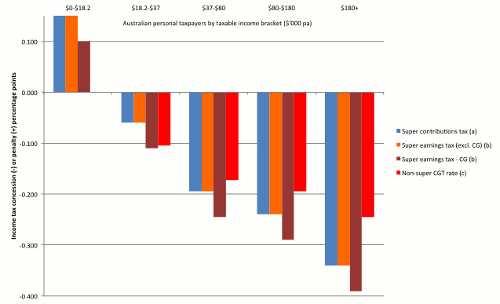Negative gearing is blamed for pricing first home buyers out of the housing market, for asset price bubbles (notably, again, housing), lost Budget revenue, and benefiting the rich. The Financial System Inquiry interim report apparently agrees. Most recently, this debate has been re-activated by the Housing Industry Association and (again) by Saul Eslake.
Is negative gearing a tax concession?
Recent commentary seems quite unburdened by reference to long-established tax design principles. Treasury's Tax Expenditures Statement (2013) defines the personal income tax benchmark from which concessions are measured as including all nominal income, less all nominal expenses incurred in earning income. (We can debate inflation adjustment of the income tax base and tax rates later).
Advertisement
Interest costs of borrowing to purchase income-generating assets (whether housing or other assets) should be allowed as deductible expenses, even if (as with negative gearing) they exceed income (eg, from rent) generated by the asset.
Negative gearing isn't a tax concession. It's a proper part of the income tax base.
So what's the problem? There are several income tax concessions. Capital gains (CG) are taxed under CGT when realized, not as they accrue, offering tax deferral benefits. 'Trading' capital gains aside, the applicable CGT is discounted between 33.33% (super funds accumulation phase), 50% (most non-super capital gains) and 100% (the family home and super funds pension phase). Super contributions and earnings aren't taxed the same as income either.
See Chart for some of these.
Chart. 'Headline' nominal CGT and superannuation tax discounts for Australian taxpayers *

* Tax discounts are shown as percentage point tax concessions (negative columns) or penalties (positive columns) relative to income tax on wages, interest and dividends.
(a) In most cases based on a contributions tax rate of 15%. For contributors on incomes over $300,000, the contributions tax rate is 30%.
(b) Super funds in the accumulation phase.
(c) 'Non-trading' capital gains (ie, for assets held for over one year).
Source: Geoff Carmody & Associates.
These concessions rise with income, and are zero or negative below the tax-free threshold. This reflects fixed percentage capital gains tax discounts, and fixed super contributions and earnings taxes, relative to 'progressive' personal tax rates on wages, interest and dividends. Additional tax advantages arising from ability to defer realisation of capital gains aren't shown.
Advertisement
So why would governments ban negative gearing under an income tax?
In short, tax revenue. Current borrowing cost tax deductions come before capital gains realisations. Banning them boosts tax today. The price of the ban is increased tax distortions, and thus less revenue, over time.
All governments are inherently risk-averse revenue raisers. They want to maximize tax revenue ASAP, while shifting revenue risks to the taxpayer.
Discuss in our Forums
See what other readers are saying about this article!
Click here to read & post comments.
24 posts so far.